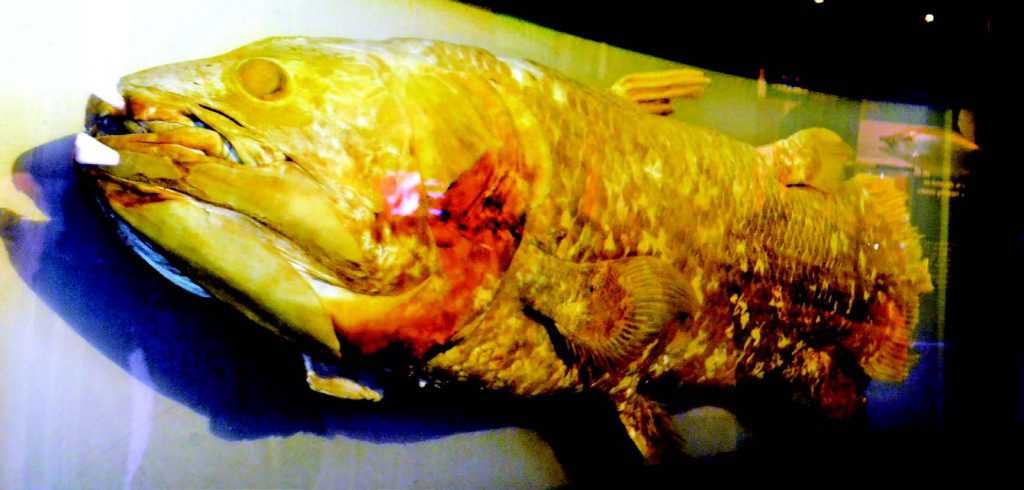A phone call preluded one of the greatest scientific discoveries of all time.
Three days before Christmas 1938, South African museum curator Marjorie Courtenay-Latimer got a call that would forever change the course of scientific history. “Miss Latimer, we are down at the docks and have a 1.5-ton fish,” said Captain Harry Goosen, captain of the Nerine, a local trawler. He usually saved interesting finds for the museum and now his crew had caught something very, very special. “I have fished in the region for over 30 years, but this is the first I have seen. Maybe you are interested?”
It was still early, so Marjorie had time to grab her stuff and go to the port, like what she had done countless times before – but nothing prepared her for what she saw. “I picked away at the layers of slime to reveal the most beautiful fish I had ever seen,” she recalled. “It was five feet long, a pale mauvy blue with faint flecks of whitish spots. It had an iridescent silver blue and green sheen all over and was covered in hard scales. Moreover, it had four limb-like fins and a strange puppy dog tail.”
She had the fish wrapped and somehow convinced a taxi to haul the slimy giant back to South Africa’s East London Museum, just a few kilometers away.
But after hours of poring through textbooks and scientific journals, she still couldn’t identify the fish! Running out of time and with one of the 20th century’s greatest finds melting before her eyes, she took it to the morgue for freezing. They said no.
Out of options, she hired a taxidermist to gut and skin the mysterious animal. Two months later, her friend JLB Smith, a chemist and fish expert from Rhodes University, arrived to help identify it.
“Now that … is a living fossil. I wouldn’t be more surprised than if I had seen a dinosaur walking down the street,” he said. The lobed fins and primitive body type were dead giveaways of a lineage that had been alive for 365 million years but supposedly went extinct with the dinosaurs, 65 million years ago. “There is not a shadow of a doubt. It is like seeing a creature from 200 million years ago come to life once more.”
Living fossil
Though locals have for generations known the fish as the Gombessa, Smith would later name the fish Latimeria chalumnae after Marjorie Courtenay-Latimer and the Chalumna River, near where the fish was caught. Scientists believe that up to 90 different coelacanth species once inhabited not just the world’s oceans – but rivers and lakes too.

The second big coelacanth discovery was on 30 July 1998, according to a 1998 Nature article by Henry Gee, when fisherman Om Lameh Sonathan and his crew pulled another strange fish off the volcanic island of Manado Tua in Indonesia. The 29-kilogram fish was eventually brought to Dr. Mark Erdmann, a researcher from the University of California who had been looking for the fish for 10 months, ever since his wife spotted one at a fish market in Manado. Unlike the blue-hued African Coelacanth (Latimeria chalumnae), the newly-discovered Indonesian Coelacanth (Latimeria menadoensis) is brownish and known by locals as Raja Laut – King of the Sea.

The discovery of this second species suggests that more coelacanth populations might still be holding out in other regions – but finding new ones has so far proven difficult. First, coelacanths prefer steep, cold drop-offs with caves and crevices from 100 to 500 meters deep – far beyond the range of most SCUBA divers. Secondly, they’re rare and widely-dispersed even in their home ranges. Lastly, an expedition to probe these little-known habitats and find wild coelacanths by design rather than chance would require extensive preparation and likely cost millions of Pesos which can be better-spent protecting other marine species.
Today, coelacanths are the best examples of a Lazarus taxon, creatures once thought forever gone.
Knowing that we have rediscovered animals long thought to be lost to time, The Wild Side wonders: What other creatures can be hidden by darkness and depth? Ancient ammonites? Trilobites? A Megalodon? Who knows? The next discovery might just be a phone call away.
You might want to read:
– So long Sheldon: An underwater memoir for the dog who loved to dive
– Capturing underwater creatures with a camera
– Scientists discover four new species of walking sharks






